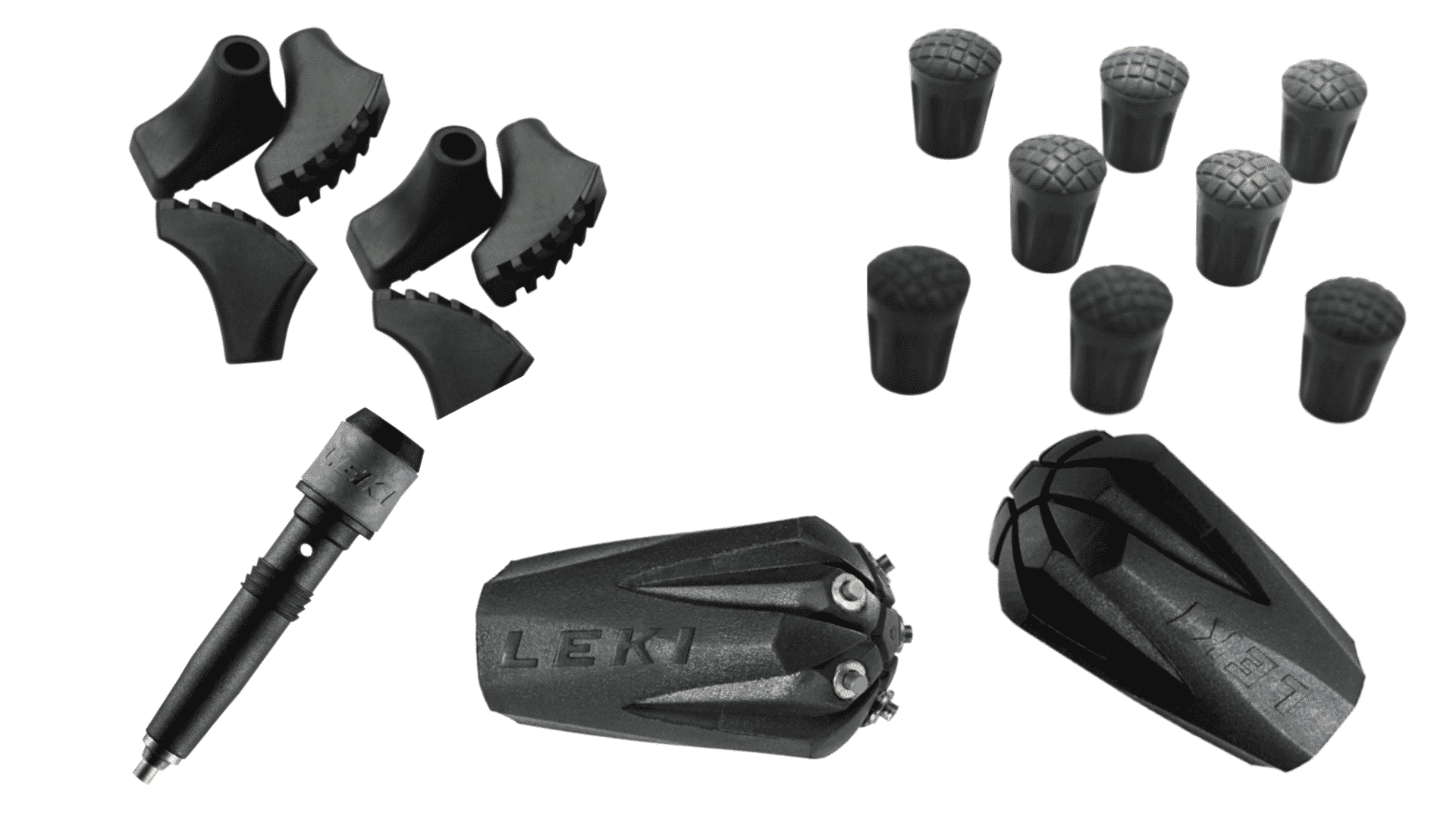All the benefits of trekking poles start with tips. This is the point where your pole comes into contact with the ground providing traction. Almost every trekking pole on the market comes with hardened steel/carbide tips, but that isn’t your only option.
Do you regularly hike on hard surfaces like cement, asphalt, gravel, or even indoors? Than maybe you should consider purchasing rubber tips to help increase traction and reduce the damage on your poles.
Table Of Contents
Rubber vs Carbide Trekking Pole Tips
Whether or not you prefer rubber or carbide trekking pole tips all boils down to your own personal hiking style. Traditional steel/carbide trekking pole trips provide excellent traction on soft natural surfaces and are extremely durable.
Steel tips do have a few downsides. They are a pain to replace, wear down on hard surfaces, and make a lot of noise. On the other hand, rubber tips offer more traction on hard surfaces, but you sacrificing traction on soft ground.
If you’re trying to protect your pole tips, while reducing noise rubber tips are the way to go. They can be replaced in seconds and significantly cut down on the ware and tear of your poles.
Why Use Rubber Trekking Pole Tips?
People use rubber trekking pole tips for a wide variety of reasons. Backpackers/hikers seem to either love or hate rubber tips depending on their hiking styles and the type of terrain they’re walking on. These are some of the benefits of rubber hiking tips.
- Decrease Wear on Trekking Poles: If you do a lot of walking on hard surfaces(indoors, cement, asphalt) your factory tips will quickly wear away. Rubber tips will greatly extend the life of your factory tips and save you a lot of money in the long run.
- Less Noise: Every hiker knows the click-clack-click-clack sound of trekking poles coming up behind them. That can get super annoying over the course of a long hike.
- Easier to Replace: Factory steel/carbide tips can be replaced, but it’s kind of a pain in the butt. On the other hand, rubber tips slide on and pop off instantly.
- Cheap to Replace: Rubber tips are so cheap that they are more or less disposable(check these tips out). You can expect to get about 40 hours out of your rubber trekking pole tips.
- Protect The Ground: Carbide tips poke holes and scratch up surfaces in high-visitation parks.
- Improved Traction on Hard Surfaces: Standard steel/carbide tips are better in mud, dirt and soft surfaces and rubber is better on rock, asphalt, gravel and cement.
Different Types of Trekking Pole Tips
Choosing the right pair of rubber tips really isn’t rocket science. They all serve the same basic purpose of protecting your poles while providing more traction on hard surfaces.
The style you choose isn’t going to have all that much impact on the way you hike. However, there are a few basic differences that are worth noting.
Carbide/Steel Tips
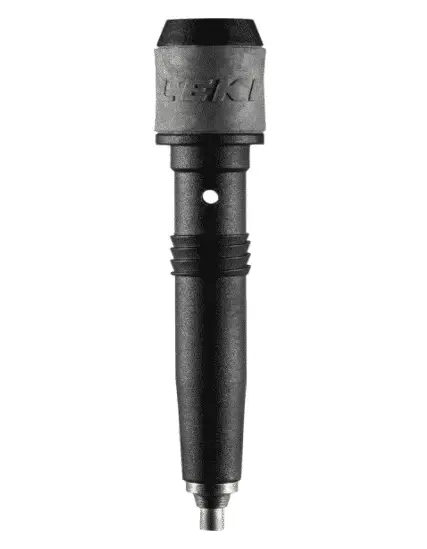
Almost every single trekking pole on the market comes with hardened steel/carbide tips(cheap poles might not). Steel tips are great for all around use. They provide lots of traction in mud, gravel, ice, snow, etc. Your tips will wear down eventually, and they can be replaced(it’s a pain).
There are four main downsides to steel trekking pole tips(all can be overlooked). They are noisy, hard to replace, slip on hard surfaces and they leave marks on the trail. Whether or not you choose to choose use rubber tips is entirely up to you.
Cheap Standard Rubber Tips
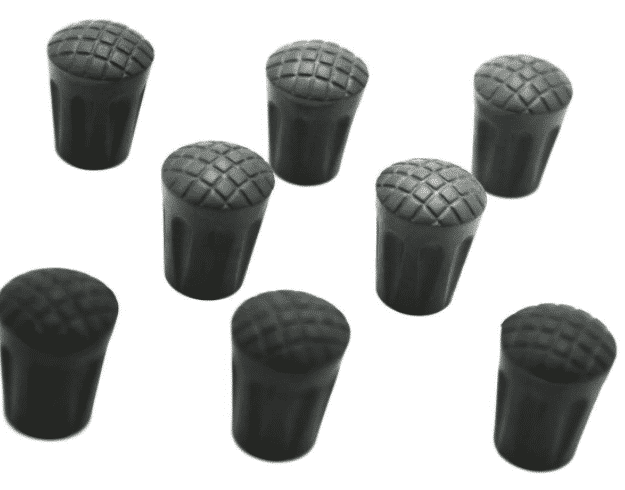
These are by far the most popular tips and probably the only ones you’ll ever see in your local outdoor sporting goods store. Ever heard the saying “A Jack of All Trades is a Master of None”?
That perfectly describes the standard cheap rubber trekking pole tip. They protect your pole tips, provide traction on hard surfaces, and protect the trail, but they don’t really stand out in one particular area.
These are great replacement tips to keep in your pocket or toss in your pack as spares, but you can better suit your hiking style with other styles. That being said, for the price they are definitely worth purchasing as spares(check out the price).
Extra-Durable Tips
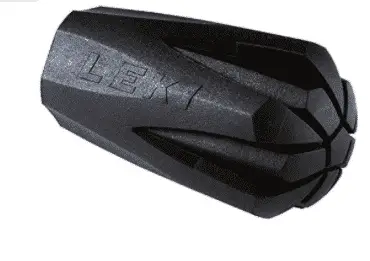
If you’re serious about hiking do yourself a favor and skip the cheap generic rubber tips. You will probably only get about 30-50 miles out of standard tips. They are great as backups and spares, but you should really just spend the extra money on tips that will actually last.
All major trekking pole companies like Leki and Black Diamond sell their own brand of extremely durable tips. In all honesty they are probably all made in the same factory overseas so the quality will be more or less the same.
Personally, I use Leki’s Standard Rubber tip on all of my trekking poles. I have well over 500 miles on my tips any they still have lots of life left in them.
These tips are universally made out of hardened vulcanized rubber that provides extra grip and a way longer life. Although they are only recommended for pavement and indoor use they work really well on all surfaces. You lose a little bit of stability on dirt/mud, but the difference is negligible.
Spiked and Studded Tips
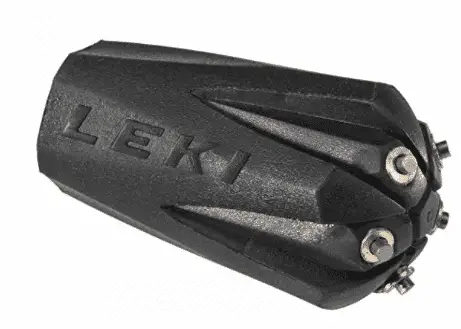
Spiked tips only recently came out and they’re kind of a hybrid between traditional steel tips and rubber tips. They have all the benefits of traditional rubber tips without the downsides. The only problem is they cost a small fortune compared to other options (check out the price).
You get the traction of steel in dirt/mud without sacrificing on hard surfaces. These tips really do offer the best of both worlds(wish they were cheaper). Another added bonus is they seriously cut down on noise.
Expect to get a few thousand miles out of these tips. Honestly they will probably outlast your poles if you do a lot of technical hiking through rock/debris.
Road Feet aka Boot Tips
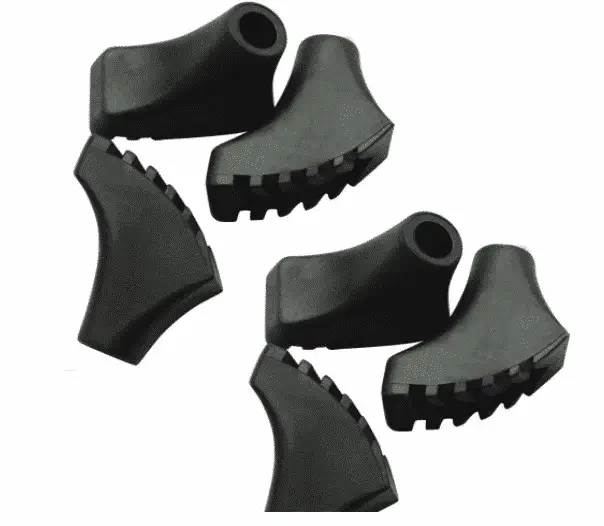
These are basically just going to be used by backpackers traveling overseas. They are designed to be used on hard surfaces like asphalt and cement by power walkers and fitness enthusiasts.
Boot tips offer all the benefits of traditional ribber tips with the added cushion and propulsion of a rounded rubber tip. They will wear out faster than traditional models, but the benefits far outweigh the reduced life expectancy.
Picture the way tires look on a car. Thats the direction you want to put these tips on your pole. The rubber tip should face forward so that it curves and pushes off as you walk. Putting them on backwards would be like walking on the tips of your toes.
